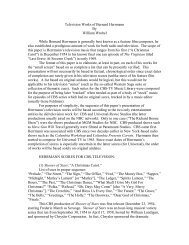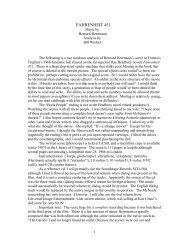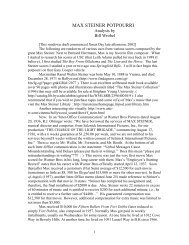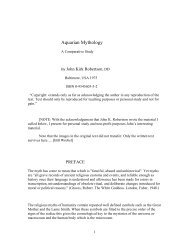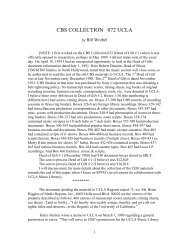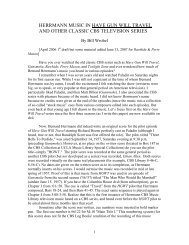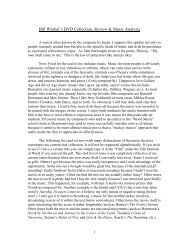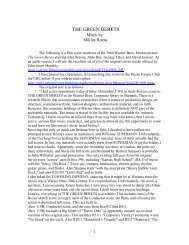Valentine's Day, Sunday, February 14, 2010 at 10:20 am
Valentine's Day, Sunday, February 14, 2010 at 10:20 am
Valentine's Day, Sunday, February 14, 2010 at 10:20 am
- No tags were found...
Create successful ePaper yourself
Turn your PDF publications into a flip-book with our unique Google optimized e-Paper software.
Went out with the wife for dinner <strong>at</strong> Red Brick Pizza (delicious Greek salad and whiteBianco pizza with sausage and vegetarian on my half), then Trader Joe's, then Walgreens,etc.Quote: "In For the Fallen, Herrmann immedi<strong>at</strong>ely plays with use of linear fifths andoctaves, slowly infusing the melodic line with super-imposed augmented fifths and majorsevenths ..."The VC/CB play an ostin<strong>at</strong>o on Gre<strong>at</strong> octave E quarter note to E 8th figures. Combinedmuted violins play Line 2 B quarter note up to Line 3 E 8th up to B quarter note down toE 8th. So th<strong>at</strong>'s a P4 interval (B up to E) and a P5 interval (E up to B, its inverserel<strong>at</strong>ionship). So we have an octave with the B and a fifth but also a 4th. In Bar 2, in thes<strong>am</strong>e p<strong>at</strong>tern, we have A up to E up to A down to E. So now we have a P5 (A up to E)and then P4 (E up to A). In Bar 3, we have G up to D up to G down to D. So P5 to P4again. In Bar 4, the p<strong>at</strong>tern is still there but now the intervals are tritones (unexpectedly)with F# up to C (d5 tritone) and th<strong>at</strong> C up to F# (A4 tritone)--classic and f<strong>am</strong>iliardissonant device used by Herrmann right up to the end of his career. So Herrmann had aM2 (whole tone) descent of starting B to (Bar 2) A, and then another M2 descent of th<strong>at</strong>A in Bar 2 to (Bar 3) G starting note, but then a m2 descent of th<strong>at</strong> G to (Bar 4) F#.Wh<strong>at</strong>'s interesting in Bar 2 is th<strong>at</strong> top staff celli start to play the ostin<strong>at</strong>o on Gre<strong>at</strong> octaveB notes (while the lower staff VC and CB still play on E notes). So Herrmann in effect iscleverly playing with the inherent quartal p<strong>at</strong>tern of B to E to A. In Bar 3 the violas nowstart the ostin<strong>at</strong>o on small octave C notes to (Bar 4) D notes. But then the music becomesclearly <strong>am</strong>biguous (hmmm...is there such a thing as "clear <strong>am</strong>biguity"?!) in Bars 3 & 4with the added layer of notes.Quite frankly, I never much cared for this "berceuse" but Herrmann constructed itcleverly. Normally I associ<strong>at</strong>e a berceuse as a lullaby, and this work hardly qualifies inth<strong>at</strong> specific sense. Perhaps it demonstr<strong>at</strong>es a certain tranquil n<strong>at</strong>ure but it's a very sad onein terms of subject m<strong>at</strong>ter (for the fallen). So did Herrmann misinterpreted or mislabeledthis work as "A Berceuse"I wonder?? It's nothing in character to th<strong>at</strong> f<strong>am</strong>ous berceuse ofBrahms' lied Wiegenlied (cradle song) or Chopin's Opus 57. I don't know. But it's <strong>am</strong>inor subject for deb<strong>at</strong>e perhaps.He employs quartal harmony far less frequently in his l<strong>at</strong>er works, although you hear itnow & then (such as the "Stone Faces" cue of N by NW). In Bar 16 he has in effect theF# half-diminished 7th (F#/A/C/E) and other half-dim sevenths l<strong>at</strong>er on--and he reallyloved th<strong>at</strong> tonality throughout his writing career! Herrmann is certainly not <strong>am</strong>biguous <strong>at</strong>the end of the piece. We hear a clear Bb major (Bb/D/F) tonality. Herrmann tempo-marksthis end section as an appropri<strong>at</strong>e Molto Tranquillo (berceuse-speaking!).Time for a tranquil sleep!_______________________________________________talkingherrmann mailing list124




